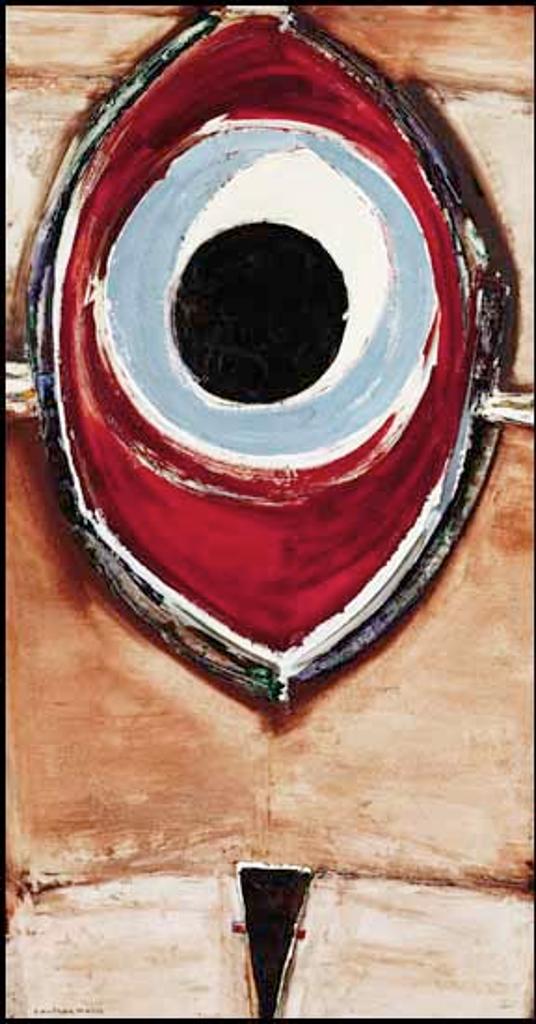
Le cercle dans notre univers
94 cms x 48.3 cms (37 ins x 19 ins)
Signed and on verso signed and titled
Lot offered for sale by Heffel, Vancouver at the auction event "November 2011 Online auction" held on Sat, Nov 26, 2011.
Lot 317
Lot 317
Estimate: CAD $6,000 - $8,000
Realised: CAD $3,510
Realised: CAD $3,510
Lot description - from the online catalogue*
Provenance:
Private Collection, Toronto
Literature:
Édith-Anne Pageot, "Henriette Fauteux-Massé, L'oeuvre abstrait", Vie des Arts, No. 200, Fall 2005, page 41
Notes:
Henriette Fauteux-Massé participated actively in the effervescent avant-garde and intellectual movement that swept Quebec in the 1950s and 1960s. Along with her contemporaries Marcelle Ferron, Marcelle Maltais, Lise Gervais and Rita Letendre, she assertively chose to follow abstraction to emancipate herself from a repressed and alienating social and religious past. From 1946 to 1949 she lived in New York, then pursued her studies at the André Lhote school in Paris. In 1951 she returned to Montreal permanently, joining the Association des artistes non-figuratifs de Montréal. Some have defined her art as hybrid - as Édith-Anne Pageot writes, "à la croisée des principales tendances qui divisent à l'époque le milieu de l'art actuel québécois soit le post-automatisme, sensible à une gestualité lyrique, et l'abstraction géométrique." (at the crossroads of the major movements which at the time divided the Quebec art world, be it Post-Automatist, with its sensitivity to a lyrical gesture, and geometrical abstraction.) But it is through her travels and contact with fellow artists that Fauteux-Massé defined her artistic style, be it in a conscious or unconscious (or Automatist) way. This fine work from 1970 is significant as it was done shortly before she left abstraction and returned to figurative art and poetry. This painting intrigues the viewer, as through its abstract language one can perceive figurative forms and space.
Private Collection, Toronto
Literature:
Édith-Anne Pageot, "Henriette Fauteux-Massé, L'oeuvre abstrait", Vie des Arts, No. 200, Fall 2005, page 41
Notes:
Henriette Fauteux-Massé participated actively in the effervescent avant-garde and intellectual movement that swept Quebec in the 1950s and 1960s. Along with her contemporaries Marcelle Ferron, Marcelle Maltais, Lise Gervais and Rita Letendre, she assertively chose to follow abstraction to emancipate herself from a repressed and alienating social and religious past. From 1946 to 1949 she lived in New York, then pursued her studies at the André Lhote school in Paris. In 1951 she returned to Montreal permanently, joining the Association des artistes non-figuratifs de Montréal. Some have defined her art as hybrid - as Édith-Anne Pageot writes, "à la croisée des principales tendances qui divisent à l'époque le milieu de l'art actuel québécois soit le post-automatisme, sensible à une gestualité lyrique, et l'abstraction géométrique." (at the crossroads of the major movements which at the time divided the Quebec art world, be it Post-Automatist, with its sensitivity to a lyrical gesture, and geometrical abstraction.) But it is through her travels and contact with fellow artists that Fauteux-Massé defined her artistic style, be it in a conscious or unconscious (or Automatist) way. This fine work from 1970 is significant as it was done shortly before she left abstraction and returned to figurative art and poetry. This painting intrigues the viewer, as through its abstract language one can perceive figurative forms and space.
Most realised prices include the Buyer's Premium of 18-25%, but not the HST/GST Tax.
(*) Text and/or Image might be subject matter of Copyright. Check with Heffel auction house for permission to use.
(*) Text and/or Image might be subject matter of Copyright. Check with Heffel auction house for permission to use.